
Travel: Marble Rocks, Jabalpur
The white cliffs of Bedaghat
The Marble Rocks (Bedaghat), just outside the mining town of Jabalpur in Central India, arguably rates alongside the Taj Mahal as one of India’s most awesome sights. It isn’t marketed as one, though and that is indeed unfortunate.
I began my journey with a boat ride on the emerald waters of the Narmada river, which winds its sinuous way between the looming, impassive white cliffs of Beraghat.
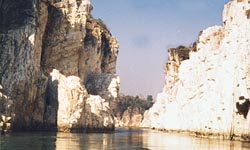
The boat, built in the style of a shikara, is manned by three men, ostensibly acting as our guides. All queries about the holy river meet with a deafening silence till a certain point in the river is past.
After which, Guide One swings into his commentary, at a rattling pace that encourages neither thought nor sceptical question.
As is the case at most of India’s natural and man-made wonders, the tourist is left to rely on the guide’s patter, though many of the “facts” may not pass muster.
Consider Guide One and Two’s varied comments on the Narmada, at different times during the hourlong boat ride: “Here the water is 240 feet deep (this, a few feet away from the jetty and the water-smoothened golden pebbles); now it is 420 feet deep (20 minutes down the river); here it is 600 feet deep (in the belly of the gorge).
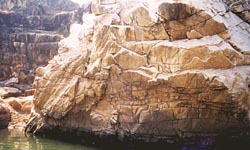
They also inform us that this is where Jis desh main Ganga behti hain was shot, the same place where Kareena Kapoor sang “Raat ka nashaa” in Asoka, the very same place where Rekha was pushed to her death in Khoon bhari maang and Nargis sang with Raj Kapoor in Awara.
There is an outcrop of white rock in the centre with a gleaming shivling on it; we are told that the valorous Ahilyabai Holkar placed the linga there.
We pass three or four caves cut deep into the cliffs and the guides, animated now, say that a sadhu lives there and point out that a young woman from Bhopal did tapasya for “years and years and years” inside.
We are also told that the rocks are pure marble, second in comparison only to the famous Makrana marble of Rajasthan.
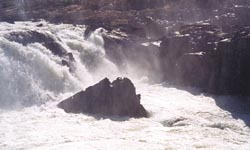
Like all of India’s major rivers, the Narmada too has her own Suicide Point, though a fall from any point along the clifftop would have to be suicidal.
There is also a bhool bhulaiya, a fluid crossroads of the river. During the rains, copious as they are in these parts, the Narmada rises to awesome heights, virtually turning Beraghat into an island cut off from the mainland.
Here and there are whirlpools and deep eddies made by the cross currents. The limestone rocks are not an unrelenting white, occasionally you spot shades of blue, blush pink and of course, boulder black. The combination of dark waters and light rocks make for a visually stunning sight.
To the south of the river are the famed Lamheta rocks, one of the oldest rock formations on earth, supposedly with agate, carnelian, garnet and crystal embedded into them. The Lamheta rocks are believed to be over 1500 million years old and traces of fossils were found here some years ago.
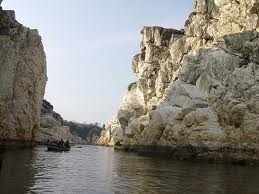
Deep in the heart of the gorge at Beraghat, the guides mercifully fall silent and that is when the Narmada begins to work its magic on us.
The day is clear and golden, the sky is a deep blue, and the air has a sharp tang to it. The cliffs tower above us, neither protecting nor threatening. Just being. Little whirlpools gurgle faintly and the silence is so serene, so beautiful, you wish you could sail down the river forever.
Boat rides during the time of the full moon are popular specially during Sharad Purnima, which is when the moonlit gorges take one’s breath away; on that night, local artistes perform
at the rocks, with the serene waters turning into an inky shimmering sheet, shot here and there with silver.
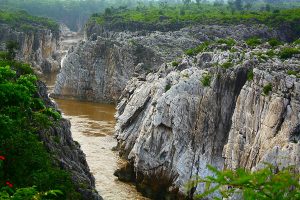
The holy river, said to be created by Shiva himself and named to mean “one who bewitches”, is a joyous and beautiful creation of immense use to those who live by its banks. Starting clear as a stream at Amarkantak, the Narmada swells eventually to a huge volume of water and weaves its way beside sal, teak and bamboo forests inhabited by sambhar, cheetal and leopards.
Meadows of red laterite soil interspersed with dense green vegetation fringe its banks even as it reflects the dense azure of the sky above. It makes its way to the falls at Duandhar in Jabalpur swiftly and strongly. The Duandhar ledge is not more than 30 feet high but the river falls with much drama and the spume that rises gives the place its name.
The waters fall in the most delicate, frothy lace like pattern as they rush, changing colour in
their wake, towards where the Marble Rocks stand sentinel along with the 10th
century Chausat Yogini temple at a height of 150 feet. These have stood here, even before the Narmada formed and flowed through them. Long before the stone cutters came to carve figures of white stone. And long before there was a proliferation of tourists and guides in the area.
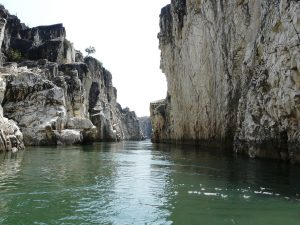
This ran in THE NEW INDIAN EXPRESS of 7 March 2013.
All photos by Sheila Kumar and subject to copyright.
Related Links:
Travel: Bhimbetka Caves, Madhya Pradesh
Travel: Bhopal, Madhya Pradesh
Travel: Sanchi, Madhya Pradesh
Travel: Bhojeshwar Temple, Madhya Pradesh